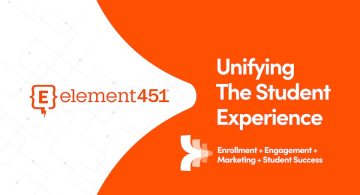Overcoming Declining Enrollment in Colleges
by Sirley Carballo · Updated Sep 13, 2024

Overcoming the Challenges of Declining Student Enrollment in Higher Education
Undergraduate enrollment in colleges and universities across the United States has encountered troubling ebbs and flows in recent years. The National Center for Education Statistics reports that U.S. college enrollment declined by 15 percent from 2010-2021, reaching an all-time low of 15.4 million students. The community college landscape has also experienced a downward trend in freshmen enrollment over the years, with many leaders focused on ensuring longevity for this type of institution.
If you’ve spent any time around higher ed campuses, you know that students are the reason these institutions exist. It’s students who define and shape the collegiate culture. Institutional leaders must address enrollment challenges as a path toward defining their relevance and sustainability.
In this blog post, we’ll explore the current state of student enrollment numbers, discuss the reasons for admissions issues, and delve into the impact that these trends have on higher education institutions and surrounding communities.
Understanding the Reasons for Declining Enrollment in Higher Ed
Declining student enrollment happens as a result of multiple factors. The reasons can also vary in nature, from academic, to personal, to financial.
Broader trends, like the overall decrease in high school graduates, the relative affordability of college degrees, and changes in the availability of vocational careers all contribute to college enrollment numbers. Inside Higher Ed also reports that in today’s economy, fewer high school graduates go directly to college, a deviation from historical precedents. Trends like these are especially prominent among lower-income communities or in high school regions in which more minority students attend.
Combined, these factors cause students to choose alternative pathways and explore non-traditional options (as we might typically think of the college experience). Choices like trade schools, career-based education, and other vocational training are gaining steam. If higher ed institutions hope to remain competitive, enrollment leaders must analyze generational data and study new demographic patterns for a particular region.
Addressing Enrollment Issues in Response to Data
As enrollment staff and admissions officers observe shifting societal values and the perceptions on undergraduate degrees, it’s vital to adapt and stay flexible. Creating innovative enrollment management strategies that are tailored to specific student populations can make the most impact over time—especially for schools that desperately need to reverse negative trends.
Next, we’ll go over a few tips to help you cultivate a sense of ownership over any current or upcoming enrollment problems at your college or university.
Practical Steps for Higher Education Leadership
The first step in addressing declining enrollment is to identify the reasons behind it. Higher education faces a variety of challenges in the current landscape, but there are also bright spots. Since the pandemic, “total undergraduate enrollment is projected to increase by 9 percent to 16.8 million students.” Leaders can take advantage of these new projections by carefully addressing the following concerns.
Demographic Shifts
The small number of high school graduates per year in the United States does result in a smaller pool of potential college-enrolling students for two and four-year institutions. This means that of the students who are graduating high school, colleges need to forge stronger connections to capture interest. Dual enrollment courses offer students the chance to save time and money in high school by earning college credits before they step foot on a college campus.

Get A Demo of Element451
Put students at the heart of your enrollment marketing with tools that reveal who they are and what’s important to them. Then, deliver personalized messages on the best channel at the best time — automatically across the entire student journey.
See it in Action
Rising Tuition and Cost of Living
The cost of higher education has steadily risen over the past decade, a concerning trend that outpaces some inflation estimates and other economic indicators. Schools must be willing to offer more enticing aid packages, reduce living expenses, or move to flexible learning formats that save time and resources. In the midst of a student loan debt crisis, American students are notoriously skeptical of accruing more debt.
Changing College Student Preferences
Younger students may be more inclined to seek alternative paths to success when compared with pre-pandemic levels of interest. New opportunities, like vocational training or entrepreneurship in the online space could mean that college degrees hold less appeal. To counter these opinions, college marketing leaders need to create compelling value propositions which convince students of the worth of different degree programs.
Student Support Investments
Colleges and universities must prioritize supportive programs that cater to the changing needs of a new student body. Programs that incorporate mental health counseling and financial planning can serve students at both public schools and private institutions.
Stronger Retention Efforts
For colleges, retention is as critical as initial recruitment. Institutions must instill the importance of student success and prevent dropouts through targeted programs and personalized offerings. Retention is especially important for first-generation students, black students, and international students who may face harsher long-term consequences for enrollment loss.
Leverage Marketing and Branding to Combat Enrollment Declines
Colleges and universities may also be able to improve enrollment rates by giving a fresh look to their overall marketing and branding strategies.
The revamped marketing process starts with buy-in from leaders, and it trickles down to other departments and staff members. As a guiding rule, recruiters and admissions team members must have the resources necessary to develop personalized college messaging.
Student-centric engagement programs can also generate more impact by creating a campus culture that appeals to generational interests and values. In other words, you’re prioritizing what matters most to the students—a major differentiation from simply marketing what your staff or faculty like about the college experience.
A fresh marketing perspective might also include immersive social media campaigns, targeted digital advertising investments, and or on-campus events that attract prospective students. The goal with each of these ideas is to appeal strongly to students’ unique emotions, motivations, and decision-making beliefs.
>> Focus on your students with the Complete Guide to Student Engagement. <<
Reduce Financial Barriers to Student Enrollment and Achievement
The cost of tuition and related expenses remains one of the most significant barriers to pursuing higher education. The Education Data Initiative points out a shocking statistic that the current price of an undergraduate degree is nearly 23 times higher than it was during the 1960s. And although several decades have passed between then and now, the truth is that prospective freshmen simply don’t earn enough to compensate for staggering price hikes.
To ethically overcome financial barriers to student enrollment, institutions must regularly review and modify scholarship and financial aid programs as a way to expand opportunities—particularly for students that are most adversely affected by economic difficulties.
Promoting additional waivers, frequent scholarship initiatives, and payment plan options can help remove or mitigate the initial concerns students have. Moreover, colleges may be able to collaborate with external partners (or regional and local businesses) to create inventive new student funding solutions and bridges to future employment.
Offer Innovative Course Offerings for New Generations
Even in a digital world, attracting students often boils down to the ability to provide innovative and unique academic course options.
Today’s colleges must eliminate the roadblocks that have kept students in the same type of learning patterns for decades. With new multidisciplinary and digital approaches to education, contemporary institutions should be able to cater to more students who crave new experiences and learning paths. Thinking outside of the “traditional degree program” box isn’t simply a good idea anymore—it’s invaluable.
Plus, by offering courses in emerging fields that are directly tied to cultural and economic growth, institutions stay competitive and top-of-mind. With a turbulent job market, students want to hold degrees that take them in the right direction (versus holding them back from finding stable, long-term careers).
Develop Lasting Relationships with Local Communities
Another way to counter declining enrollment numbers is to envision a comprehensive college community—one that isn’t exclusive to dormitories and college classrooms.
When colleges and universities strengthen relationships with local communities, leaders have a chance to instill new opportunities for students to participate in internships, job shadowing, and practical training sessions.
Creating a rich culture of community-based learning and engagement holds benefits for both institutions and students, and it might even be the missing piece to the decades-long enrollment puzzle. Local businesses, schools, and civic organizations often benefit greatly from a college presence. To head off enrollment troubles, it may be time to look more closely at the mutual benefits that exist in these separate areas.
Why Enrollment Matters to the Future of Higher Ed
Declining enrollment remains a crucial challenge for institutions that want to stay relevant, but it’s hardly the end of the road. By analyzing and addressing the root causes for enrollment troubles, admissions offices around the country can overcome and boost longevity.
A nimble and innovative approach remains the key to success in a fast-paced world. As a result, institutions that invest resources into adapting to changing student needs, wants, and expectations are those that will thrive. McKinsey & Company provides the following real-life example regarding the sharp pivot to online opportunities and adult learner segments.

Distance learning is unquestionably on the rise, with online programs enabling more students than ever before to earn their degree either in part or entirely away from campus. Nowhere is this shift more evident than with adult learners. Both labor-market changes and increasing automation in the workforce suggest greater demand for re-skilling, which could result in more adult learners looking for online or hybrid education solutions.

Although declining student enrollment presents a concrete threat for the viability of colleges and universities, proactive responses may keep those risks at bay. On the flip side, simply reacting to new cultural changes as they happen may leave schools short on time and recruiting resources when they need them most.

Practical ChatGPT Prompt Engineering Tips for Higher Ed
Unlock the power of ChatGPT and AI tools to transform your higher education marketing and enrollment strategies! Our resource explores five key prompts to master - tone, subject lines, personalization, idea generation, and creative direction - and provides practical tips on how to leverage them in your communications.
Get the Guide
Plan for the Future with Element451
Element451 is a trusted partner on the road to better enrollment and enhanced student engagement. With AI-powered communications, personalized campaigns, and responsive CRM solutions for colleges and universities of all sizes, we’re here to help you move into your next chapter.
Get more confident on your enrollment strategy today.Request a call with our team to discuss your enrollment challenges.

About Element451
Boost enrollment, improve engagement, and support students with an AI workforce built for higher ed. Element451 makes personalization scalable and success repeatable.
Categories
New Blog Posts

The Definitive Guide
AI in Higher Education
Bridge the gap between the latest tech advancements and your institution's success.
Useful Links
Related Articles

Talk With Us
Element451 is the only AI Workforce Platform for higher education. Our friendly experts are here to help you explore how Element451 can improve outcomes for your school.
Get a Demo








